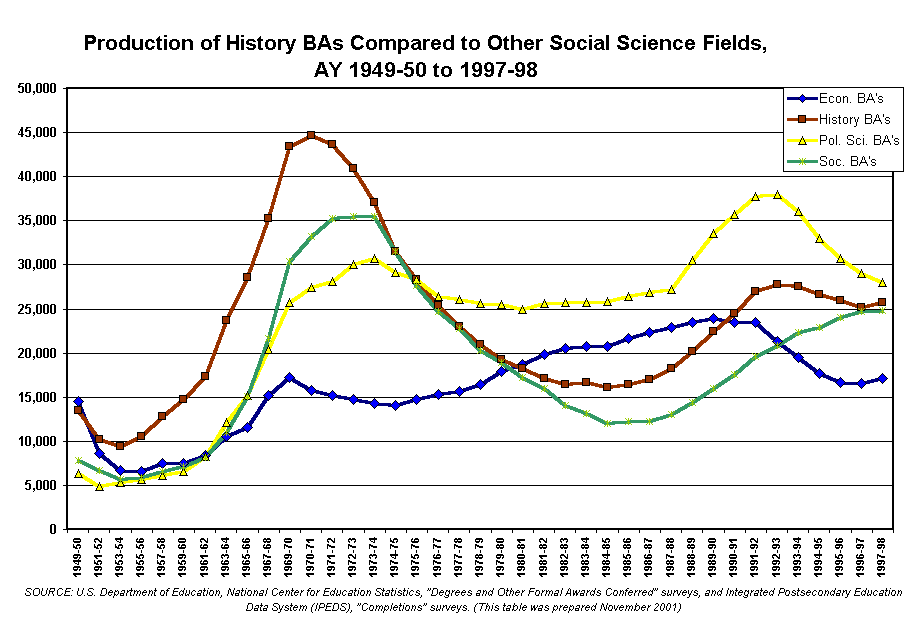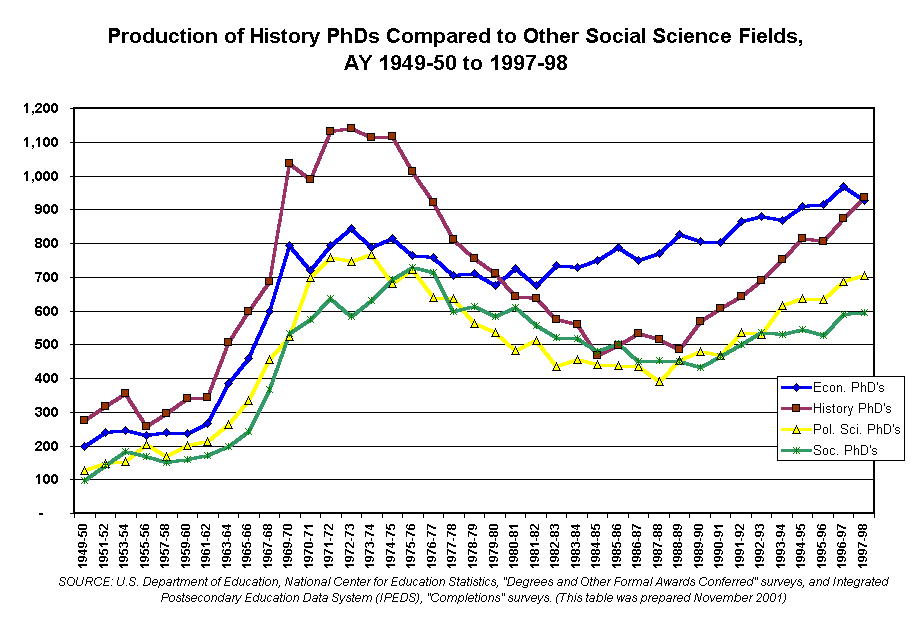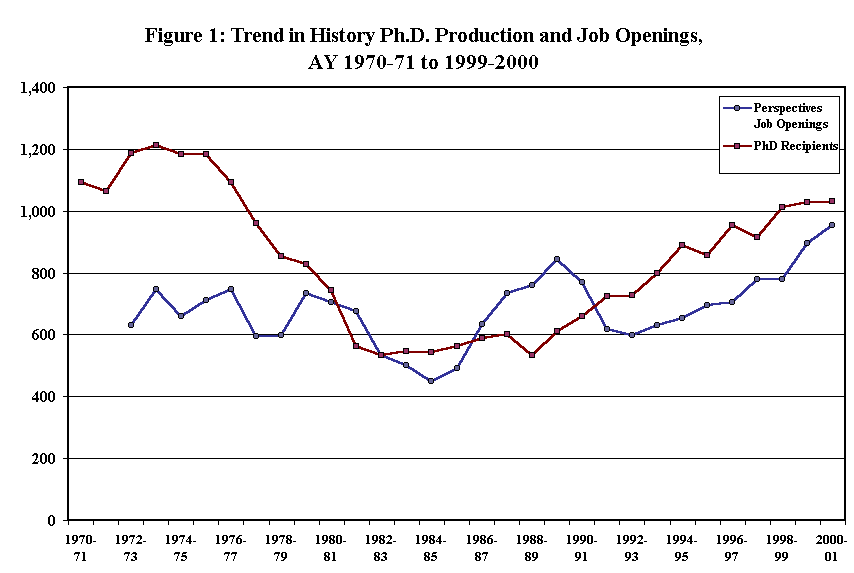Professional Issues
Precedents: The Job Crisis of the 1970s
The current sense of crisis in the job market pales when compared with the surfeit of history Ph.D.’s produced in the 1970s that created a “lost generation” of historians. In contrast to recent annual disparities of about 20 percent between new jobs and new Ph.D.’s, at the height of the 1970s job crisis the disparity rose to nearly 50 percent. Given that graduate training in history was primarily directed toward employment in colleges and universities, it is notable that more than a third of those who received history Ph.D.’s ultimately had to find employment elsewhere.

This disparity was largely precipitated by the demographic bulge of “baby boomers,” which began to swell enrollments in the early 1960s. From 1960 to 1970, the production of history B.A.’s rose 67 percent (see figure on BA production), creating enormous demand for history teachers. As a portion of these history B.A.’s followed the apparent demand for history teachers into history Ph.D. programs, the number of new history Ph.D.’s doubled from 507 in 1964 to 1,092 in 1970 (see figure on PhD production). This growth was accelerated by the rapid introduction of new Ph.D. programs, which increased from 80 in 1960 to 122 by 1971.

During the 1970s, however, the production of history B.A.’s fell 56 percent, even as the total number of undergraduates at colleges and universities remained fairly constant. As student interest shifted to professional and work-related fields such as business, engineering, and general education, the humanities and social sciences suffered. Even when compared with the B.A. production in the other social science disciplines during this period, the number of undergraduate history majors fell sharply. Interest in studying history flagged as the history requirements for teacher certification and graduation were reduced or eliminated.
As early as 1969, members of the AHA committee on the professional register (the precursor to the annual meeting Job Register and employment listings in Perspectives ) noted the arrival of a “‘time of troubles’ for the fledgling historian,” as it became clear that “jobs were in short supply.” The signs of crisis were evident quite early in the decade. A 1970 survey of Ph.D. programs found that less than half of their students seeking employment had found “satisfactory positions” over the previous year. The New York Times reported that at the 1970 AHA annual meeting 2,481 applicants vied for 188 job openings. The following year, the Association identified a surplus of 800 job-seekers who had been unable to find employment.
One of the first signs of change in the job market was a waning expectation that academic employment was possble without the Ph.D. In 1970 only 18 percent of those listed with the professional register already had their Ph.D. in hand. By the mid-1970s, AHA surveys of the academic job market did not see the need to even mention the numbers of M.A.’s and ABDs seeking employment.
The disparity between jobs and Ph.D.’s grew throughout the 1970s, particularly as the number of those unable to find jobs grew. Even after history faculties identified the crisis and applied the brakes to graduate enrollment—either by cutting admissions or discouraging promising history students from pursuing the Ph.D.—it took quite a few years for reductions in admissions to translate into reductions in doctorate production. Given that it takes an average of almost eight years from admission to completion of the Ph.D., it was not until the end of the latter part of the decade that these efforts produced a reduction in the number of Ph.D.’s awarded. As a result, the disparity between the annual number of new Ph.D.’s and the number of openly advertised positions was quite striking throughout the 1970s (See figure comparing PhD and Job Production).
Many solutions were offered to address the “demand” side of the problem as well. As early as the 1971 AHA business meeting, resolutions were introduced to encourage older faculty members to “retire at the minimum retirement age” and to encourage schools to hire part-time faculty whenever possible, at proportionately the same pay scale as full-time faculty. In 1974 the AHA Council voted to support these proposals and encouraged schools not to hire Ph.D.’s who already had full-time employment outside the academy.
These efforts produced a number of objections. The pressure for retirements was criticized as an attack on top-quality senior faculty. Encouraging the hiring of part-time faculty was viewed as simply creating a new tier of impoverishment. And those who had obtained full-time employment to pay for their graduate studies objected to the Council’s last proposal for obvious reasons.
On the supply side, numerous proposals were also offered to curtail the production of new Ph.D.’s but few, if any, were implemented. A number of historians (typically scholars at elite Ph.D. programs) suggested halting the creation of new Ph.D. programs until the employment crisis passed, and pressuring state legislatures to eliminate funding for “marginal” programs, and balancing admissions to Ph.D. programs to correspond to shifts in the job market. The faculty at programs labeled “marginal” objected, arguing that their departments served a much wider commitment to improve the diversity of historical scholarship and the historical profession than the elite schools. Despite the proposals to cut programs and balance admissions, the number of Ph.D. programs continued to grow (to 142 by 1980). However, the number of applications for admission to history Ph.D. programs fell rapidly after 1970.
The more successful efforts to address the problem looked beyond the immediate dynamics of the academic job market. In 1977 the National Coordinating Committee for the Promotion of History was established to increase public awareness of the historical profession and open up new areas of employment for historians in the federal government and private sector. Similarly, in the early 1980s the Organization of American Historians-Fund for the Improvement of Post-Secondary Education project worked to disseminate information on the job situation and how new Ph.D.’s might be better prepared to enter a job market in which four-year colleges and universities were but one employer among many.
In the end the situation began to improve when the eight-year lag in the Ph.D. pipeline fell into line with the job market. However, the job crisis of the 1970s produced a significant demographic shift in the employment patterns of history Ph.D.’s. In 1977, the first year for which comprehensive data on the employment of history Ph.D.’s is available, 87 percent of those with history doctorates were employed in four-year colleges and universities. But by the end of the decade, only about 65 percent of those who received history Ph.D.’s in the 1970s had been able to find employment in the academy. Even though the total number of history Ph.D.’s employed in the academy grew 22 percent between 1977 and 1983, the number employed outside the academy rose 355 percent, to more than a third of those with history Ph.D.’s.
Sources
With the exception of the data used for the statistical graphs, all data and information for this essay came from the annual reports, newsletter, and published minutes of the American Historical Association, 1968–1983.
Tags: Job Markets
Comment
Please read our commenting and letters policy before submitting.







